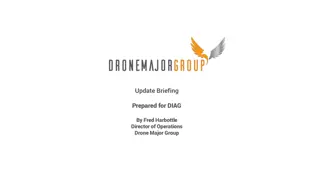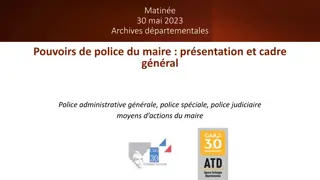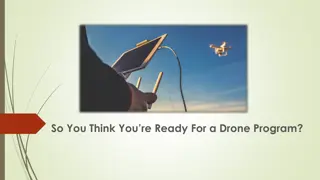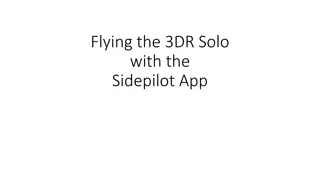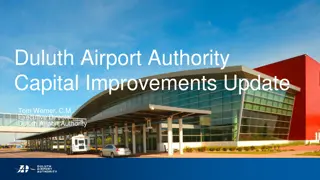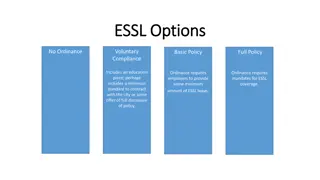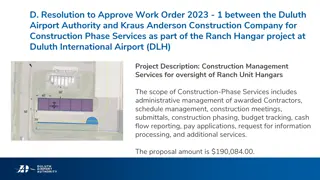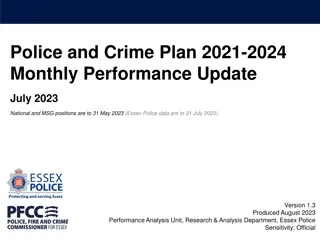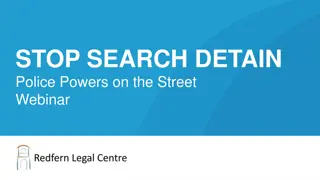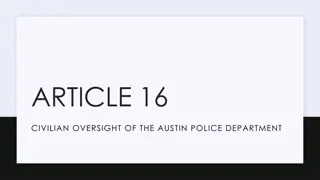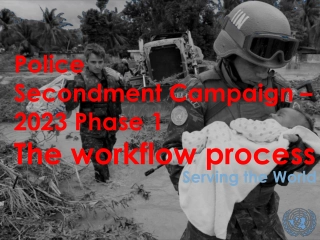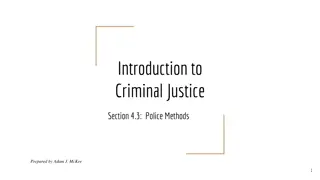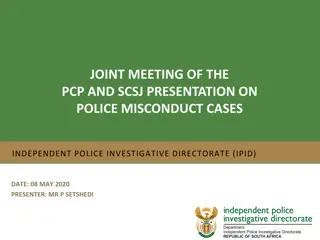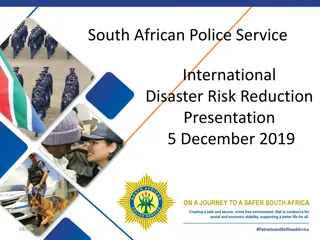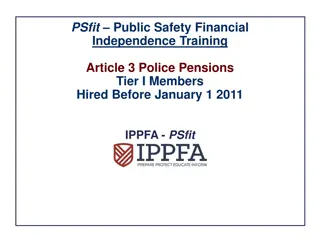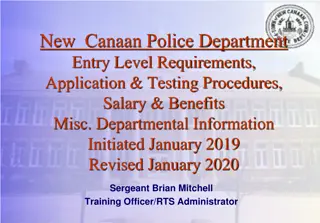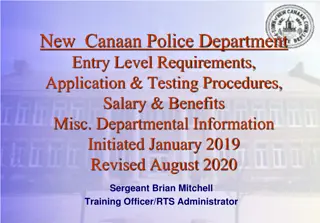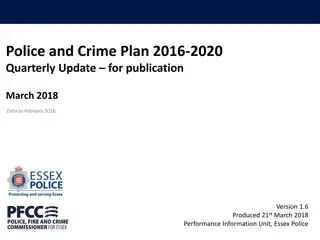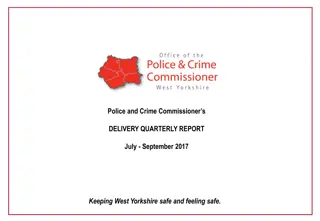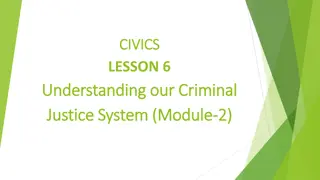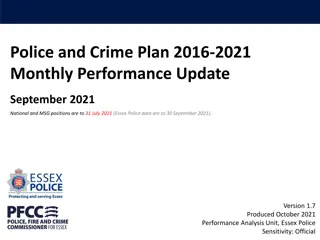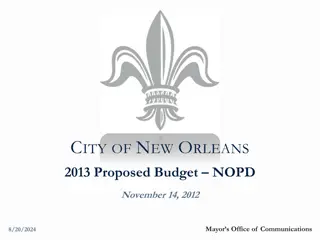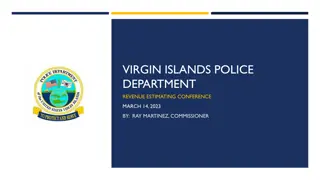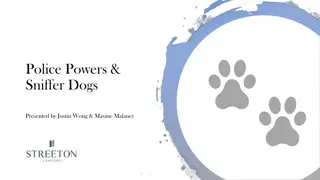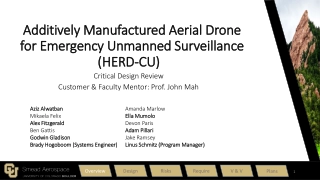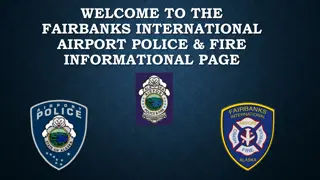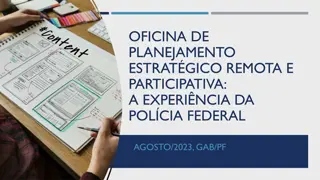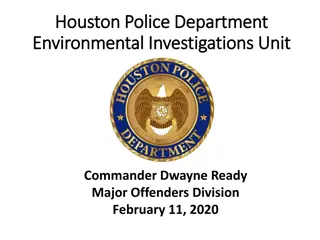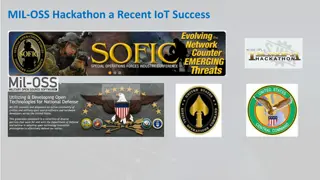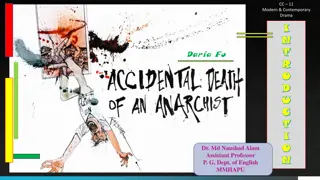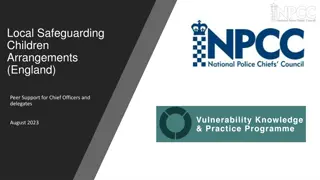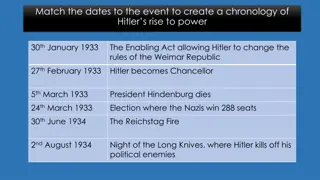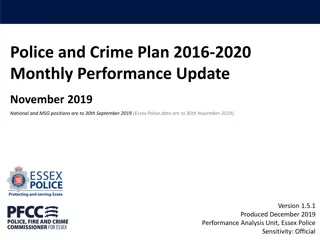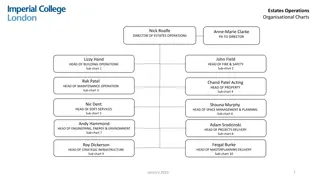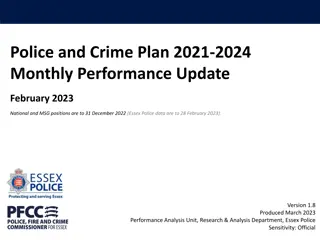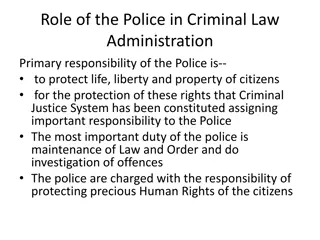Drone Team Operations and Regulations Overview by Duluth Police Department
The Duluth Police Department operates a Small Unmanned Aerial System (SUAS) Drone Team regulated by FAA and Minnesota State Statute 626.19. The team follows strict FAA regulations, state statutes, and departmental policies for SUAS operations. Compliance with search warrant requirements, restricted data collection, and annual reporting is emphasized. Regular training and adherence to established best practices are integral to the team's operation.
Download Presentation

Please find below an Image/Link to download the presentation.
The content on the website is provided AS IS for your information and personal use only. It may not be sold, licensed, or shared on other websites without obtaining consent from the author. Download presentation by click this link. If you encounter any issues during the download, it is possible that the publisher has removed the file from their server.
E N D
Presentation Transcript
Duluth Police Department SMALL UNMANNED AERIAL SYSTEM (SUAS) DRONE TEAM
Drone Team - Overview SUAS operations (commercial and hobby) are regulated by the Federal Aviation Administration (FAA) DPD SUAS pilots operate under FAA Part 107 (Small UAS Rule) and acquire a Remote Pilot s License from the FAA
Drone Team - Overview Law Enforcement use of an SUAS is regulated by Minnesota State Statute 626.19 (Use of Unmanned Aerial Vehicles) DPD SUAS pilots follow FAA regulations, Minnesota State Statute and departmental policy
Drone Team - Overview FAA regulations and established best practices involve flight logs, training logs and maintenance logs. DPD SUAS pilots will train regularly both individually and as a team
Minnesota Statute 626.19 Drone use requires a search warrant, unless it meets one of the authorized warrantless use exceptions in 626.19 Subd. 3. Drone use must comply with FAA requirements and guidelines. Drones must not use facial recognition or biometric-matching technology unless expressly authorized by a warrant
Minnesota Statute 626.19 Drones must not be equipped with weapons Drones must not be used to collect data on public protests or demonstrations unless expressly authorized by a search warrant or one of the exceptions under Subd. 3.
Minnesota Statute 626.19 Reporting Requirements Any police agency that maintains or uses a SUAV must report yearly to the Minnesota Department of Public Safety the following: Number of deployments without a search warrant, including the date and authorized use Total cost of SUAV program
Minnesota Statute 626.19 Reporting Requirements Any judge that approves or denies a warrant for the use of a SUAV most report yearly to the state court administrator That a warrant was applied for, the type of warrant, whether the warrant was granted, extended, modified or denied, the offense specified in the warrant, the law enforcement agency applying for the warrant.
MN Statute Warrantless Use Exceptions (1) during or in the aftermath of an emergency situation that involves the risk of death or bodily harm to a person; (2) over a public event where there is a heightened risk to the safety of participants or bystanders; (3) to counter the risk of a terrorist attack by a specific individual or organization if the agency determines that credible intelligence indicates a risk; (4) to prevent the loss of life and property in natural or man-made disasters and to facilitate operational planning, rescue, and recovery operations in the aftermath of these disasters;
MN Statute Warrantless Use Exceptions (5) to conduct a threat assessment in anticipation of a specific event; (6) to collect information from a public area if there is reasonable suspicion of criminal activity; (7) to collect information for crash reconstruction purposes after a serious or deadly collision occurring on a public road; (8) over a public area for officer training or public relations purposes; and (9) for purposes unrelated to law enforcement at the request of a government entity provided that the government entity makes the request in writing to the law enforcement agency and specifies the reason for the request and proposed period of use.
Regulations continued: Documentation of each use per statute: Unique case number Factual basis for its use Applicable exception, unless a warrant was obtained Reported to Minnesota Bureau of Criminal Apprehension annually
Regulations continued: Prohibited use: Random surveillance Target a person based solely on actual/perceived characteristics such as race, ethnicity, religion, sex, national origin, sexual orientation, gender identity, economic status, age, cultural group, or disability To harass, intimidate, or discriminate against any individual or group To conduct personal business Weaponized
Potential deployments: Natural or man-made disasters Large-scale events (Grandmas Marathon, Tall Ships, Bayfront Concerts, Inline Marathon, etc.) Dignitary Visits to Duluth/Assisting Secret Service Tactical Response Team Support (high risk search warrants, armed barricaded suspects, hostage situations) Crash/Crime Scene reconstruction and documentation
Potential deployments: Aid in locating missing persons, vulnerable adults, suicidal subjects High Risk Patrol Response (in progress crimes of violence, searching, K-9 support) Foreign and domestic terrorism acts/threats Surveillance of criminal suspects per statutory requirements
Deployment Process Unit requesting SUAV must obtain supervisor approval to confirm deployment follows DPD policy Supervisor then must get approval from Remote Pilot-In-Command to confirm deployment. Remote PIC will review flight plan and confirm if deployment is safe and feasible (location, weather, objectives, etc.) Unit requesting SUAV obtains search warrant if necessary before deployment, or confirms deployment meets warrantless deployment authorization by Minnesota State Statute
Deployment Process FAA / Duluth ATC approval of operation if needed per Federal guidelines Deployment/Flight is conducted with Remote PIC and visual observers in support. The Remote PIC can end the deployment at any time if they believe it becomes unsafe or unfeasible to continue After deployment/flight, flight logs are completed, any evidence collected is downloaded, police reports completed (if needed) and any FAA reports are completed (if needed)
Deployment Process SUAV deployments are reviewed biennially by DPD. The review includes FAA registration checks, MN DOT registration checks, FAA Part 107 license checks, flight log reviews, maintenance log reviews, report reviews. SUAV also has an automated electronic log of all deployments that cannot be modified by the user and can be reviewed at any time by DPD
Overview of actual deployments: Armed barricaded subject (Suspect shot at officers, shot and killed police K9, continued to threaten officers with a firearm) Barricaded subject (possibly armed, drone used to identify window of opportunity to make arrest after confirming subject was not armed) High risk search warrant (assisting St Louis County Sheriff s Office in search warrant to clear an attic space)
Overview of actual deployments: Armed barricaded subject (attempted bank robbery, attempted car-jacking, discharging firearms inside apartment, shooting at SUAV) Assisted T.R.T. in searching apartment for domestic violence suspect who discharged a firearm inside apartment with victim inside Assisted T.R.T. in clearing residence at the scene of quadruple murder/suicide
Overview of actual deployments: Aided patrol response in suicidal subject locked in vehicle who discharged a firearm in the city Crime scene reconstruction involving multiple scenes of arson and suicide attempt Surveillance during controlled purchases of heroin/fentanyl from suspects with previous violent crime convictions, including one with a homicide conviction
Summary: SUAS (drone) use has become standard used in modern police agencies across the United States to include Minnesota. The benefits of the use of drone technology by police are numerous. Drones allow for police to search potentially dangerous areas without putting human or canine lives at risk.
Summary: Drone costs are much lower than other aerial support methods used by law enforcement, such as helicopters or airplanes. The use of drones is another example of Duluth Police as a progressive police department, being on the cutting edge of new technologies and practices.
Prepared by: Sgt. Rob Hurst rhurst@duluthmn.gov Inv. Matt Nevanen mnevanen@duluthmn.gov



